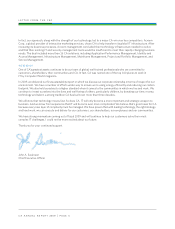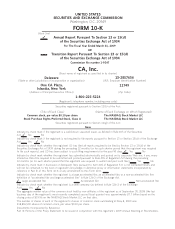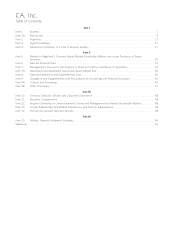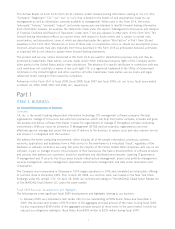Computer Associates 2009 Annual Report Download - page 16
Download and view the complete annual report
Please find page 16 of the 2009 Computer Associates annual report below. You can navigate through the pages in the report by either clicking on the pages listed below, or by using the keyword search tool below to find specific information within the annual report.Our product development staff is global, with locations in Australia, Canada, China, the Czech Republic, Germany, India,
Israel, Japan, the United Kingdom and the United States. We collaborate in both physical and virtual labs. Our
technological efforts around the world ensure we maintain a global perspective of customer needs while cost-effectively
tapping the skills and talents of developers worldwide, and enable us to efficiently and effectively support our customers.
In the United States, product development is primarily performed at our facilities in Redwood City, and San Francisco,
California; Lisle, Illinois; Framingham, Massachusetts; Ewing, New Jersey; Islandia, New York; Pittsburgh, Pennsylvania;
Plano, Texas; and Herndon, Virginia.
Patents and Trademarks
Certain aspects of our products and technology are proprietary. We rely on U.S. and foreign intellectual property laws,
including patent, copyright, trademark and trade secret laws to protect our proprietary rights. However, the extent and
duration of protection given to different types of intellectual property rights vary under different countries’ legal systems.
In some countries, full-scale intellectual property protection for our products and technology may be unavailable, or the
laws of other jurisdictions may not protect our proprietary technology rights to the same extent as the laws of the
United States. We also maintain contractual restrictions in our agreements with customers, employees and others to
protect our intellectual property rights. In addition, we occasionally license software and technology from third parties,
including some competitors, and incorporate them into our own software products.
We maintain a portfolio of U.S. and foreign patents that generally expire at various times over the next 20 years.
Although the durations and geographic patent coverage for our inventions may vary, we believe our patent portfolio
adequately protects our interests. We expect to maintain a patent portfolio that includes more than 400 issued patents
and 700 pending applications in the United States and the European Union.
The source code for our products is protected both as trade secrets and as copyrighted works. Some of our customers
are beneficiaries of a source code escrow arrangement that enables our customers to obtain a contingent, limited right
to access our source code.
We are not aware that our products or technologies infringe on the proprietary rights of third parties. Third parties,
however, have asserted and may assert infringement claims against us with respect to our products, and any such
assertion may require us to enter into royalty arrangements or result in costly and time-consuming litigation. Although
we have a number of U.S. and foreign patents and pending applications that may have value to various aspects of our
products and technology, we are not aware of any single patent that is essential to us or to any of our principal business
product areas.
Product Licensing
Our licensing model offers customers a wide range of purchasing and payment options. Under our flexible licensing
terms, customers can license our software products under multi-year licenses, with most customers choosing terms of
one to three years, although longer terms are sometimes selected by customers who desire greater cost certainty. We
also help customers reduce uncertainty by providing a standard pricing schedule based on simple usage tiers.
Additionally, we offer our customers the ability to establish pricing models for our products based on their key business
metrics. Although this practice is not widely used by our customers, we believe this metric-based approach can provide
us with a competitive advantage in certain circumstances.
On licenses sold for our mainframe products and most of our distributed products, we offer our customers the right to
receive unspecified future software products for no additional fee, as well as maintenance included during the term of
the license. On licenses sold for certain products or through certain indirect channels, we do not offer our customers
unspecified future software products and do not always include maintenance with the license sale. For a description of
our revenue recognition policies, refer to Note 1, “Significant Accounting Policies”, in the Notes to the Consolidated
Financial Statements.
Competition
The enterprise management software business is highly competitive and is marked by rapid technological change, the
steady emergence of new companies and products, evolving industry standards and changing customer needs. We
compete with many established companies in the markets we serve. Some of these companies have substantially
6
























